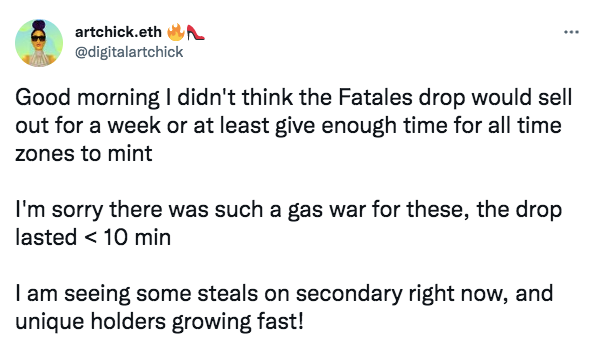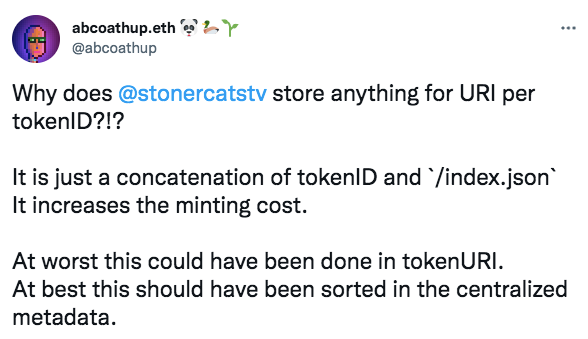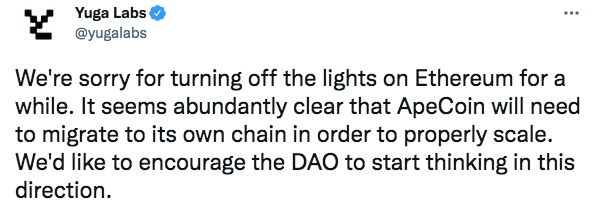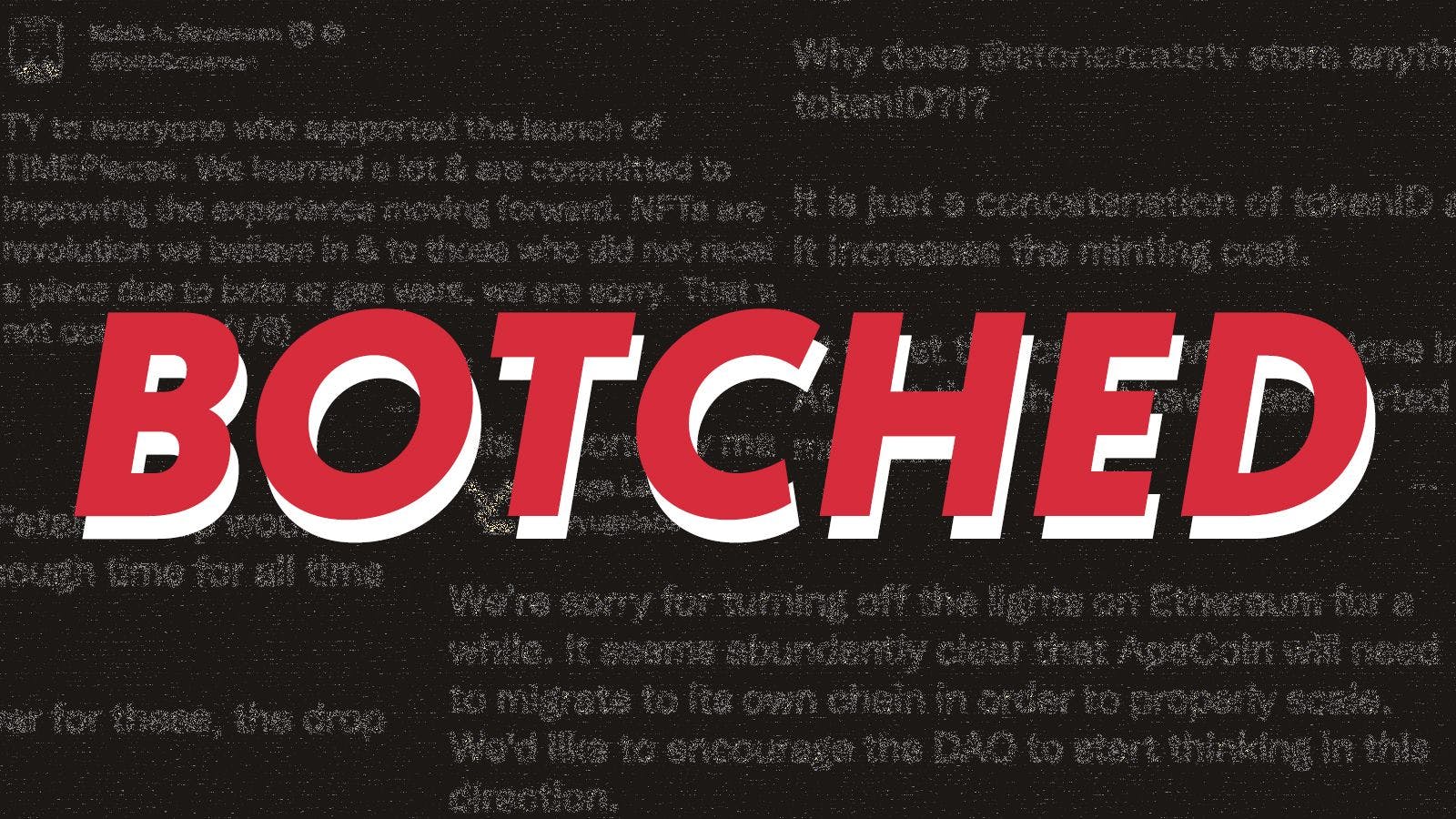#12 Fatales

https://twitter.com/digitalartchick/status/1432664501468401664
The intriguing case of Fatales revolves around how quickly the project sold out. A collection of 10,000 randomly generated female avatars with hundreds of unique traits, it was always expected to be popular - just not as popular as it turned out to be. As such, no mitigations whatsoever were put in place to ensure a smooth mint. Gas fees soared towards 2500 gwei as whales weighed in with huge bids. The project was shared heavily on social media and even Artchick (one of the influencers who supported it) expressed surprise that the mint sold out in under 10 minutes. Gas was particularly painful here because the NFTs only cost 0.03 ETH. There’s a serious point about accessibility too. Whales can afford high gas and will often push it up to secure more NFTs, pricing smaller collectors out completely.
#11 MekaVerse
This one was so bungled that people even accused the team of rigging it. Meka consists of 8888 avatars inspired by Japanese Mecha. The drop was conducted via random raffle - collectors didn’t know the identity of their Meka when they minted. The raffle was supposed to eliminate gas wars and make the drop fairer, but the team didn’t use a Verifiable Random Function to ensure that it was totally random. Instead, the code allowed team members to mint specific Mekas to specific wallets. Rumours of insider trading and rarity sniping surfaced when the avatars were revealed and several new wallets appeared to have collected all the super rare, high-value characters. Rigged or not, the lack of a VRF was a big, big miss. It was always going to expose the team to accusations. Predictably, the price of MekaVerse dropped as the rumours circulated.
#10 Stoner Cats

https://twitter.com/abcoathup/status/1419779607088164873?s=20
Another day, another bungled drop and another gas war. The story is familiar. Over 50% of transactions failed, wasting around 345 ETH in the process. This time it wasn't down to poor planning for the mint itself. The Doodles contract was flawed, meaning that if collectors didn’t manually adjust their gas fees they were more likely to fail. It might seem like a small problem, but multiply that by the 10,420 NFTs on sale and suddenly it’s apocalyptic. Despite featuring a stellar cast including Mila Kunis and Ashton Kutcher, those bad contracts have left a lingering taste.
#9 ApeCoin drop
Yes we know this isn’t a proper NFT drop but it still warrants a place on this list as truly botched. Yuga was planning to airdrop $APE to Bored Ape holders, an operation that should have been simple but was beset by problems from the outset. The price of $APE surged in anticipation but plummeted by 80% overnight as people simply cashed in their tokens for profit. Moreover, one user was able to exploit the drop for $820,000, possibly via a flash loan attack. These are complex attacks but they target vulnerabilities in smart contracts, something which could have been avoided if Yuga had followed the traditional “take a snapshot of holders” method for the airdrop. Instead, they let people buy Bored Apes and redeem coins in real-time, leading to the vulnerability.
#8 Pak’s Metamorphosis

https://twitter.com/muratpak/status/1508516647287595012
Pak has a long history in the NFT space (they’re behind Merge, the highest grossing project ever) so this drop should have been much, much better. Metamorphosis is a collaboration with 29 artists and features a “merge” mechanic, whereby NFTs can be burned to unveil new visuals. The drop sparked a gas war (foreseen by everybody, apparently, apart from Pak) with prices reaching 1000 GWEI, but that isn’t what makes this drop so terrible. Bots scooped some of the NFTs and there were also flaws in the contract. To remedy these problems, Pak decided to re-mint the collection and airdrop NFTs to original (non-bot) collectors. This meant locking the original NFTs on secondary by tweaking the contract. Collectors suddenly found that their purchased NFTs couldn’t be sold on OpenSea. This, of course, takes away people’s freedom to transact - not only one of the foundations of decentralised finance but a pillar of a free and functioning society.
#7 Doodles
Doodles is one of the most popular projects in the NFT space so it’s easy to forget that the initial drop had a 90% transaction failure rate. The first stage of the mint went well. Whitelist users minted and fees remained negligible. That all changed for the public mint. Of the 13,000 attempted transactions, a staggering 12,000 failed to the cost of 335.2 ETH. Gas wars aren’t uncommon, but failed transactions on this scale are nearly unprecedented. A few simple tweaks like a raffle system or more efficient contracts (Azuki has so far proved the master of this) are usually enough to avoid this kind of bloodbath, but neither were present here.
#6 Akutar

https://twitter.com/Micah_Johnson3/status/1517877506187186177
This drop was so bungled that Akutar managed to rug itself, locking away $34 million forever. Akutar is the brainchild of former MBL player Micah Johnson, but the contract contained basic flaws. It failed to account for multiple NFT sales in the same transaction and the numbers must add up properly to process withdrawals. The result of this bad maths? 11,539 ETH locked away in a stuck, automated smart contract forever. The developers found that they couldn’t withdraw funds, and nor could owners of the mint pass redeem their tokens. To make matters worse, the team was repeatedly warned about flaws but dismissed them as FUD or simply told whistleblowers that they were wrong.
#5 Cool Pets
Cool Pets knew what was coming. Cool Pets took steps to prevent it. Disaster struck anyway. Not only did this chaotic mint send gas prices soaring by 7000% but it left many users scratching their heads with transactions showing “pending” well after the collection had completely sold out. The team tried to mitigate some of the problems with a prior whitelist mint (allowing collectors to mind at their leisure) but all this did was decrease supply for the public mint. Just 1500 tokens for a much-hyped collection was always going to spark network congestion and chaos. The mint had already been pushed back a day because of a DDoS attack and bot swarm.
#4 The Vogu Collective
This was such a train wreck that the wallet provider presumed it was a DDoS attack. Vogu was a victim of its own hype. The Discord was bursting with excitement and the collection was widely expected to moon. It was also presumed that a massive gas war was coming. Some openly stated that they would start with 1000 gwei gas, others urged a collective approach where everyone agreed to pay a reasonable sum. That didn’t work out. 96,000 requests were sent in the first 4 minutes. Gas exploded Demand was so high that it triggered Infura API’s DDoS protection, effectively shutting the mint down.
#3 Into the Metaverse
Proof that being a big name doesn’t always equal success and efficiency, Into the Metaverse was a collaborative project between Adidas, BAYC, PUNKS Comic and Gmoney. It was also an unmitigated disaster. Demand far exceeded the number of transactions that could be processed in a single block, leading to stratospheric gas prices. 680 ETH was spent in failed transactions with a 59% fail rate. Adidas paused the mint for 20 minutes but to no real avail. There was also a big problem with bots. Collectors were supposedly limited to just two NFTs per wallet, but some were able to use bots to scoop as many as 330. Adidas later apologised to those “hurt by gas.”
#2 Otherdeed

https://twitter.com/yugalabs/status/1520612362986078208
If it seems strange to call a drop that raked in $320 million and laid the foundations for one of the biggest Metaverse expansions ever botched, then look behind the success. Yuga’s drop was such a disaster that it even crashed the Ethereum network, causing transactions to grind to a halt. Gas prices soared to 2 ETH (more than the value of the NFTs), transactions failed and frustrated users vented their fury across Twitter. The mint consumed $100 million in gas and Yuga subsequently apologised for the mess, admitting it was a “sour moment.” Even Vitalik waded in to offer some words of wisdom. Yuda did refund the gas, at least, but it seems staggering that a team this big could make such a mess. Some claimed that the contract was at fault, others suggested that the mint could have been run differently. Whatever you think, this was a low point for Yuga and so bad that they’re now talking about creating their own chain.
#1 TIMEPieces

https://twitter.com/KeithGrossman/status/1442098199838138371
TIMEPieces is regularly cited as the worst NFT drop in history and it still haunts the nightmares of many collectors. It’s another big name drop, the time from TIME magazine. TIMEPieces gave users free access to the magazine until 2023 as well as various IRL events. Unfortunately, demand was incredibly high and TIME did precisely nothing to mitigate blockchain pressure. The result? One of the highest transaction failure rates of all time at 96%. Those that did go through cost on average 2.6 ETH. To put the disaster into perspective, 90% of one block was failed transactions. The NFTs were all sold within 3 minutes but most collectors stood no chance as they went to skilled operators using bots. TIME did try to remedy the problem by apologising on Twitter (employing the tried and tested “we’ve learned lessons” line) and airdropping NFTs to people whose transactions failed, but this remains a historic failure.


